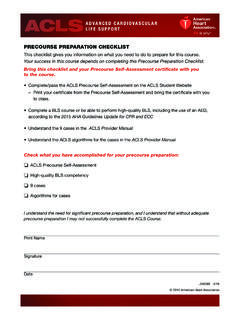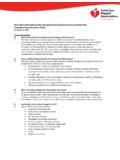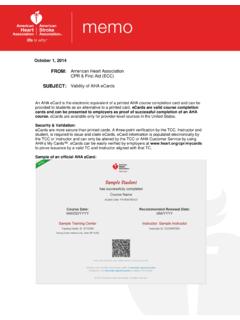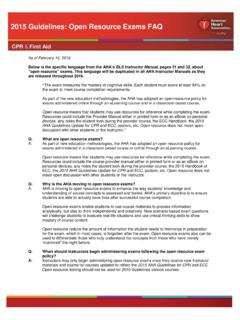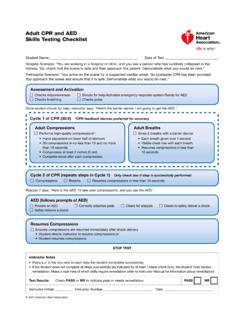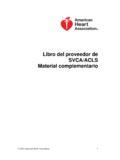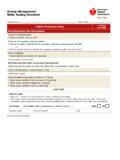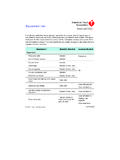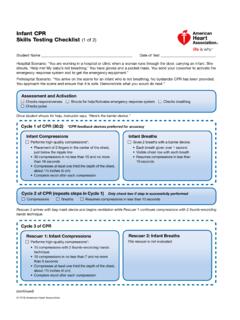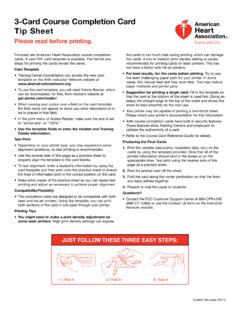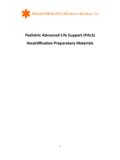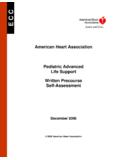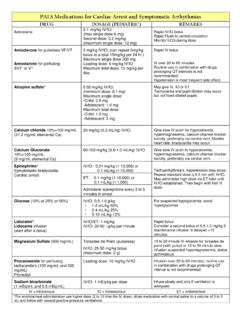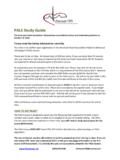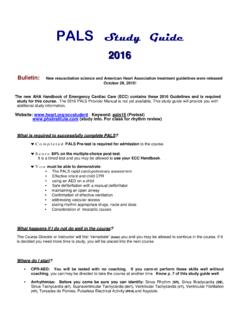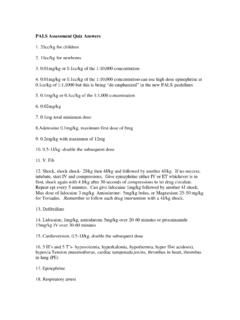Transcription of PALS Systematic Approach Summary - AHA …
1 A p p e n d i x258 pals Systematic Approach SummaryInitial ImpressionYour first quick (in a few seconds) from the doorway observationConsciousnessLevel of consciousness (eg, unresponsive, irritable, alert)BreathingIncreased work of breathing, absent or decreased respiratory effort, or abnormal sounds heard without auscultationColorAbnormal skin color, such as cyanosis, pallor, or mottlingThe purpose is to quickly identify a life-threatening the child unresponsive with no breathing or only gasping?If YES: Shout for help. Activate emergency response as appropriate for setting. Check for a pulse. Begin lifesaving interventions as NO: Continue the evaluate-identify-intervene the evaluate-identify-intervene sequence when car-ing for a seriously ill or injured child.
2 Evaluate the child to gather information about the child s condition or status. Identify any problem by type and severity. Intervene with appropriate actions to treat the problem. Then repeat the sequence; this process is Primary assessment Secondary assessment Diagnostic testsInterveneIdentifyIf at any time you identify a life-threatening prob-lem, immediately begin appropriate interventions. Activate emergency response as indicated in your practice setting. Evaluate Evaluate consists of the primary assessment (ABCDE), secondary assessment, and diagnostic AssessmentA rapid, hands-on ABCDE Approach to evaluate respiratory, cardiac, and neurologic function.
3 This step includes assessment of vital signs and pulse oximetryAirwayClearMaintainableNot maintainableBreathingRespiratory Rateand PatternRespiratory EffortChest Expansionand Air MovementAbnormal Lungand Airway SoundsOxygen Saturation by Pulse OximetryNormalIrregularFastSlowApneaNorm alIncreased Nasal flaring Retractions Head bobbing Seesaw respirationsInadequate Apnea Weak cry or coughNormalDecreasedUnequalProlonged expirationStridorSnoringBarking coughHoarsenessGruntingGurglingWheezingC racklesUnequalNormal oxygen saturation ( 94%)Hypoxemia (<94%)CirculationHeart Rate and RhythmPulsesCapillary Refill TimeSkin Color and TemperatureBlood PressureNormalFast (tachycardia)Slow (bradycardia)CentralNormalWeakAbsentPeripheralNormalWeakAbsentNormal: 2 secondsDelayed: >2 secondsPallorMottlingCyanosisWarm skinCool skinNormalHypotensiveDisabilityAVPU Pediatric Response ScalePupil SizeReaction to LightBlood GlucoseAlertResponds to VoiceResponds to PainUnresponsiveNormalAbnormalNormalLowE xposureTemperatureSkinNormalHighLowRash (eg, purpura)Trauma (eg, injury, bleeding) 2587/5/11 3.
4 44 PMAppendix259 Secondary AssessmentA focused medical history (SAMPLE) and a focused physical examDiagnostic TestsLaboratory, radiographic, and other advanced tests that help to identify the child s physiologic condition and diagnosisIdentifyIdentify the child s problem as respiratory, circulatory, or both. Determine the type and severity of the problem(s). The table below lists common clinical signs that typically correlate with a specific type of problem and its Upper airway obstruction Lower airway obstruction Lung tissue disease Disordered control of breathing Respiratory distress Respiratory failureCirculatory Hypovolemic shock Distributive (eg, septic, anaphylactic) shock Obstructive shock Cardiogenic shock Compensated shock Hypotensive shockCardiac ArrestRespiratorySignsType of ProblemSeverity Increased respiratory rate and effort (eg, retractions, nasal flaring) Decreased air movement Stridor (typically inspiratory)
5 Barking cough Snoring or gurgling HoarsenessUpper airway obstructionRespiratory distress Some abnormal signs but no signs of respiratory failureRespiratory failureOne or more of the following: Very rapid or inadequate respiratory rate Significant or inadequate respiratory effort Low oxygen saturation despite high-flow oxygen Bradycardia (ominous) Cyanosis Decreased level of consciousness Increased respiratory rate and effort (eg, retractions, nasal flaring) Decreased air movement Prolonged expiration WheezingLower airway obstruction Increased respiratory rate and effort Decreased air movement Grunting CracklesLung tissue disease Irregular respiratory pattern Inadequate or irregular respiratory depth and effort Normal or decreased air movement Signs of upper airway obstruction (see above)
6 Disordered control of breathingCirculatory Tachycardia Cool skin Weak peripheral pulses Changes in level of consciousness Delayed capillary refill time Decreased urine output Changes in skin color (pallor, mottling, cyanosis)Signs of poor perfusionSignsType of ProblemSeverity Signs of poor perfusion (see above)Hypovolemic shockObstructive shockCompensated shock Signs of poor perfusion and normal blood pressureHypotensive shock Signs of poor perfusion and low blood pressure Possible signs of poor perfusion (see above) or Warm, flushed skin with brisk capillary refill (warm shock) Peripheral pulses may be bounding Possible crackles Possible petechial or purpuric rash (septic shock)Distributive shock Signs of poor perfusion (see above) Signs of CHFC ardiogenic shockInterveneOn the basis of your identification of the problem, intervene with appropriate actions.
7 Your actions will be determined by your scope of practice and local 2597/6/11 4:25 PM
